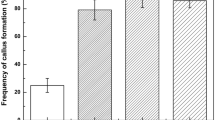Abstract
A genotype of Trifolium repens L. capable of sustaining high-frequency plant regeneration from long-term (24-month old) cell cultures has been selected. Numerous densely cytoplasmic meristemoids were formed in suspension cultures following the coordinate removal of 2,4-dichlorophenoxyacetic acid (2,4-D) and trichloropicolinic acid (picloram) from the medium and an increase in the NH +4 concentration. Some meristemoids arose from single cells in culture. Increasing the NH +4 concentration in the medium resulted in increased meristemoid formation and decreased the growth rate. Ammonium stimulated meristemoid formation when it was the sole source of nitrogen only if a lethal shift in the pH of the medium was prevented. Meristemoids plated on hormone-free agar medium developed directly into shoots which spontaneously formed roots.
Similar content being viewed by others
Abbreviations
- 2,4-D:
-
dichlorophenoxyacetic acid
- MS:
-
Murashige-Skoog (1962) medium
- NAA:
-
α-naphthaleneacetic acid
- SH:
-
Schenk-Hildebrandt (1972) medium
References
Bhojwani, S.S., White, D.W.R. (1982) Mesophyll protoplasts of white clover: isolation, culture and organogenesis. Plant Sci. Lett. 26, 265–271
Dougall, D., Verma, D.C. (1978) Growth and embryo formation in wild-carrot suspension cultures with ammonium as a sole nitrogen source. In Vitro 14, 180–182
Gamborg, O.L., Miller, R.A., Ojima, K. (1968) Nutrient requirements of suspension cultures of soybean root cells. Exp. Cell Res. 50, 151–158
Gresshoff, P.M. (1980) In vitro culture of white clover: callus, suspension, protoplast culture and plant regeneration. Bot. Gaz. (Chicago) 141, 157–164
Halperin, W. (1966) Alternative morphogenetic events in cell suspensions. Am. J. Bot. 53, 443–453
Johnson, L.B., Stuteville, D.I., Higgins, R.K., Skinner, D.Z. (1981) Regeneration of alfalfa plants from protoplasts of selected Regen S clones. Plant Sci. Lett. 20, 297–304
Kamada, H., Harada, H. (1979) Studies on the organogenesis in carrot tissue cultures. II. Effects of amino acids and inorganic nitrogenous compounds on somatic embryogenesis. Z. Pflanzenphysiol. 91, 453–463
Kao, K.N., Michayluk, M.R. (1980) Plant regeneration from mesophyll protoplasts of alfalfa. Z. Pflanzenphysiol. 96, 135–141
Keyes, G.J., Collins, G.B., Taylor, N.L. (1980) Genetic variation in tissue cultures of red clover. Theor. Appl. Genet. 58, 265–271
Kohlenbach, H.W. (1977) Basic aspects of differentiation and plant regeneration from cell and tissue cultures. In: Plant tissue culture and its bio-technological application, pp. 354–366, Barz, W., Reinhard, E., Zenk, M.H., eds. Springer, Berlin Heidelberg New York
Malmberg, R.L. (1979) Regeneration of whole plants from callus culture of diverse genetic lines of Pisum sativum L. Planta 146, 243–244
McCoy, T.J., Bingham, E.T. (1977) Regeneration of diploid alfalfa plants from cells grown in suspension culture. Plant Sci. Lett. 10, 59–66
Mohapatra, S.S., Gresshoff, P.M. (1982) Ecotypic variation of in vitro plantlet formation in white clover (Trifolium repens). Plant Cell Rep. 1, 189–192
Murashige, T., Nakano, R. (1965) Morphogenetic behaviour of tobacco tissue cultures and implication of plant senescence. Am. J. Bot. 52, 819–827
Murashige, T., Skoog, F. (1962) A revised medium for rapid growth and bioassays with tobacco tissue cultures. Physiol. Plant. 15, 473–497
Saunders, J.W., Bingham, E.T. (1975) Growth regulator effects on bud initiation in callus cultures of Medicago sativa. Am. J. Bot. 62, 850–855
Schenk, R.U., Hildebrandt, A.C. (1972) Medium and techniques for induction and growth of monocotyledonous and dicotyledonous plant cell cultures. Can. J. Bot. 50, 199–204
Syono, K. (1965) Changes in organ forming capacity of carrot root calluses during subculture. Plant Cell Physiol. 6, 403–419
Walker, K.A., Sato, S.J. (1981) Morphogenesis in callus tissue of Medicago sativa: the role of ammonium ion in somatic embryogenesis. Plant Cell Tissue Organ Cult. 1, 109–121
Wetherell, D.F., Dougall, D.K. (1976) Sources of nitrogen supporting growth and embryogenesis in cultured wild carrot tissue. Physiol. Plant. 37, 97–103
White, D.W.R. (1983) Plant regeneration from mesophyll protoplasts of white clover (Trifolium repens L.) In: Protoplasts 1983, Poster Proc., pp. 60–61, Potrykus, I., Harms, C.T., Hinnen, A., Hutter, R., King, P.J., Shillito, R.D., eds. Birkhäuser, Basel Boston Stuttgart
Wochok, Z.S., Wetherell, D.F. (1972) Restoration of declining morphogenetic capacity in long-term tissue cultures of Daucus carota by kinetin. Experientia 28, 104–105
Author information
Authors and Affiliations
Rights and permissions
About this article
Cite this article
White, D.W.R. Plant regeneration from long-term suspension cultures of white clover. Planta 162, 1–7 (1984). https://doi.org/10.1007/BF00397413
Received:
Accepted:
Issue Date:
DOI: https://doi.org/10.1007/BF00397413




